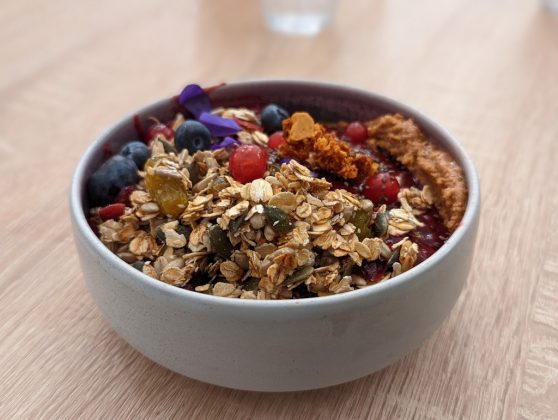![]()
Google finally opted to give its phones a new look, and some new features to match, making the Pixel 6 Pro even more interesting.
When I reviewed the Pixel 5 last year, I noted that Google went in a different direction, but this is entirely something else. Last year’s phone was a standalone device that was more mid-range in scope, and a less expensive alternative. This time around, the Pixel 6 Pro is very much a flagship, sporting a totally different look inside and out.
The result is a device that looks, feels and functions unlike its predecessors, and that includes the camera, where some key improvements put it right back among the best money can buy. While I only tested the Pixel 6 Pro, some of the features and performance do also apply to the Pixel 6 as well.
Google Pixel 6 Pro SpecsDisplay: 6.7-inch 3120 x 1440 AMOLED display 19:5:9 aspect ratio with 512 pixels per inch |
Pixel 6 Pro design
I went over some of the design points when Google unveiled the Pixel 6 and Pixel 6 Pro, but having now spent a lot of time with it, I can say it’s a welcome change in design philosophy. Previous Pixels felt utilitarian, like the kind of devices you use to do a job without really caring about how it looks. At least that’s how I can best describe the difference while using the Pixel 6 Pro.
I’m not always crazy about glass backs, but this is a nice shift in design. It makes the Pixel 6 Pro look elegant, and fits in well with the rear camera array that so prominently flows across the back. The edges are also metallic, though I don’t like that the screen has curved edges itself. A flatter screen would’ve been better. It is Gorilla Glass Victus on both sides, though, so at least there’s better protection from nicks and scratches.
The 6.7-inch AMOLED is really nice, and the Pixel 6 Pro is the biggest phone Google made to date. It features a faster 120Hz refresh rate, making navigation smoother, and Google also moved the fingerprint sensor to the-screen as well.
Under the hood, Google also made a big change by using its own processor. The new Tensor chip plays a big role in almost everything the phone does. That includes better machine learning, translating languages, camera performance, and more. I’ll go into those things as I move along in this review.
![]()
Powering old and new software
The Pixel 6 Pro starts off with Android 12, and Google says that using its Tensor chip serves to optimize how everything runs. For existing features, you will notice things are faster, but the real benefit also comes in what’s new.
Google claims Tensor makes this phone’s CPU 80% faster than the Pixel 5. I can’t quantify if that’s the exact figure, but it sure feels like it sometimes. It helps to have 12GB of RAM for running multiple apps, as is the chip’s architecture. Without getting too technical, Tensor is a system-on-a-chip (SoC), which means it combines the CPU, GPU, plus other components to increase optimization.
In practical terms, that delivers better performance for more complex tasks. For example, when you text with someone, you can use Voice Typing to state it, with proper name spelling and punctuation included. Use Google Translate, or even while texting, the Pixel 6 Pro recognizes foreign languages and works to translate them in real time. These functions work within the device, so you don’t always need an Internet connection. If you do use Translate, download the languages you want first to take advantage of that.
This new Tensor SoC also powers features like Magic Eraser within Google Photos, where you can remove unwanted portions of an image. It should be easier to play any game you want, given the more efficient use of both computing and graphics. Indeed, Google claims the Pixel 6 Pro is 370% faster on GPU performance.
There’s also a heightened focus on security through the Titan M2 security chip within Tensor. You won’t really notice much about it in the Pixel 6 Pro, but it is cool when the phone tells you that that an app is using the camera or microphone through a green icon on the top-right.
![]()
Where Android 12 comes in
Other software features are more native to Android 12, meaning you can see them on other devices, too. One unique to both Pixel 6 phones is the ability to create custom themes based on the wallpaper image you use.
I like Scrolling Screenshots, where you can take a full screenshot of a page, not just the part you see. When you take a screenshot, tap Capture More to grab it all. I find it a neat way to share articles with others, and also like that I can add text or use marker to circle something on it. About time Google added features like these.
Quick Tap is an interesting one where you can double-tap the back of the phone to perform an action. It could be to take a screenshot, access Google Assistant, show notifications or more. Could be very useful to play or pause music, even if streaming it to a speaker or headphones.
I’ve long used AppSearch as a way to quickly launch apps without scrolling for them. Only now, you can also search for stuff within apps. It could be a contact within various apps, or other shortcuts. Not all apps support the feature, so it will take some time to see how in-depth this goes. Still, I like it so far.
The new Settings drop-down menu is slicker now. Not only are sections bigger, you also have an easier way to get to them one-handed. Notifications mostly look the same, but I do find a better aesthetic this time around.
There are a bunch of other changes and features via Android 12, some of which are minor. Google guarantees three years of updates, bringing this phone to Android 15. It will be five years’ worth of monthly security updates to keep the device going longer.
![]()
About the Pixel 6 Pro camera
Google largely coasted with its camera in the Pixel 5 last year, so it’s a welcome sight to see new features in the Pixel 6 Pro. Starting with the 50-megapixel main wide sensor, you can expect images to come out looking better, and in a number of circumstances. Google says this sensor can take in 150% more light. I can’t be absolutely sure of that number, but do know how they’re doing it.
While the number says “50-megapixels” the reality is that each image is 12.5-megapixels. Google uses pixel binning, meaning it combines every four pixels to create a larger one, making it easier to capture light. You don’t get a degradation in quality, but you also don’t get the opportunity to shoot at full 50-megapixels, either.

The 12-megapixel ultra-wide and 48-megapixel telephoto lenses aren’t as sensitive to light, yet still do their part. These are great cameras capable of capturing excellent colour and detail. In fact, Google added a colour temperature slider for all its modes and lenses. Between that, and the existing shadow and highlight sliders, you have pretty good control over composition.
I got some fantastic shots while on a trip to Vienna and Budapest. Both cities are photogenic, but even if I was anywhere else, it would be hard to argue with the results. The dynamic range is excellent, giving you a chance to capture more complicated scenes. It’s not perfect, of course, as you tend to find out when trying to keep the sky detailed and foreground lit up during a sunset. Night and low-light shots are excellent, as are shots you take in Portrait mode. With the exception of the telephoto lens, the Pixel 6 will shoot the same as the Pixel 6 Pro.
![]()
New modes and video
Motion mode is the latest addition, and Google splits it in two. Action Pan lets you capture a subject in motion, freezing it while adding blur in the background. Long Exposure softens movement for more artistic and dramatic effect. Running water or moving traffic will appear smoother and more interesting, for example. The only thing is that it works best with a tripod because it’s sensitive to any movement from your own hands. Set it up on a tripod with a timer and you have a better change of getting the best shot.

Magic Eraser is going to be one that truly impresses anyone who sees it. While not entirely new, it worked well enough to impress me. It’s in Google Photos under Tools and when you rub your finger over any part of an image, Google’s AI will match pixels around it, making it disappear. I tried it with several photos, and while results weren’t always exemplary, they still worked well. One thing it can’t do is remove people’s shadows, so you will need to do that manually. Google says this is for the Pixel 6 devices because of the Tensor chip, but that may change in the months to come.
As for video, you can record in 4K resolution and up to 60fps with the main lens. Footage will look better than before, but the Pixel 6 Pro couldn’t match the dynamism and quality I was routinely getting from my iPhone 13 Pro. I also don’t like that 24fps isn’t available as an option. All the previous video features and settings stick around.
![]()
Battery life in the Pixel 6 Pro
The Pixel 6 Pro has a huge 5000mAh battery inside. Couple that with the Tensor chip, and the phone should last a full day without issue. I can say it does based on my testing, which is great to see after so-so or mediocre efforts before. The Pixel 5 wasn’t bad at all—at least for me—whereas the Pixel 4 was subpar in that regard.
The Pixel 6 Pro doesn’t come with a wall charger in the box, but does include the USB-C cabale and USB-A adapter. It supports wireless charging, as well as reverse wireless charging. I never really encountered any issues with that, using a third-party 65W charger to keep the phone topped up. I also had a wireless charging pad nearby.
Existing features, like Adaptive Battery and Extreme Battery Saver, are still there when you need them. If you go to Settings>System>Gestures, you will also find other ways to conserve battery, like Flip to Shhh and Lift to check phone. These subtle features, along with keeping screen brightness to reasonable levels, help keep the Pixel 6 Pro running into the following day. The 120Hz refresh rate is also adaptive, meaning it drops down to 10Hz when something static is onscreen.
Final thoughts on the Google Pixel 6 Pro
Last year, the Pixel 5 moved Google out of luxury territory. This year, the Pixel 6 and 6 Pro move it back in. The Pixel 6 Pro, especially, is a premium device and finally looks like one. Mid-range phones continue to draw more competition, but flagships like this are interesting when they feel different. This is a Pixel phone unlike anything that’s come before it.
The camera is undoubtedly among the best in the industry, and the marriage of hardware and software makes the phone feel natural. Consistent performance matters, as does better battery life, and the Pixel 6 Pro delivers both. If you’re okay with losing out on the telephoto camera, and can accept some other performance compromises, the Pixel 6 may be perfect for you. Otherwise, if you want the best, the Pixel 6 Pro has plenty.
The Google Pixel 6 Pro is available now at Best Buy.











